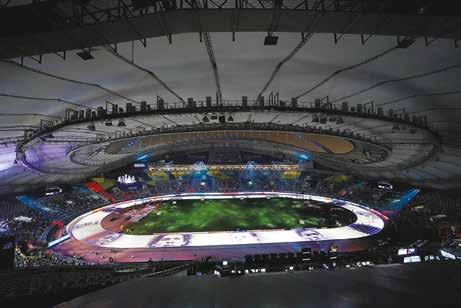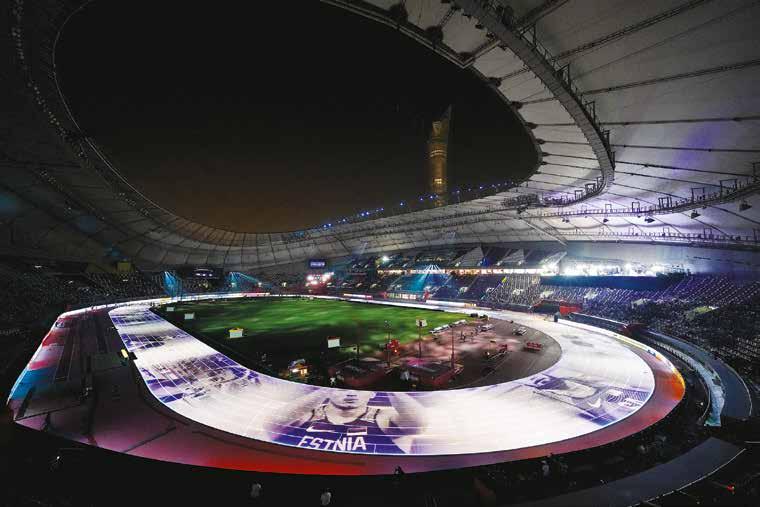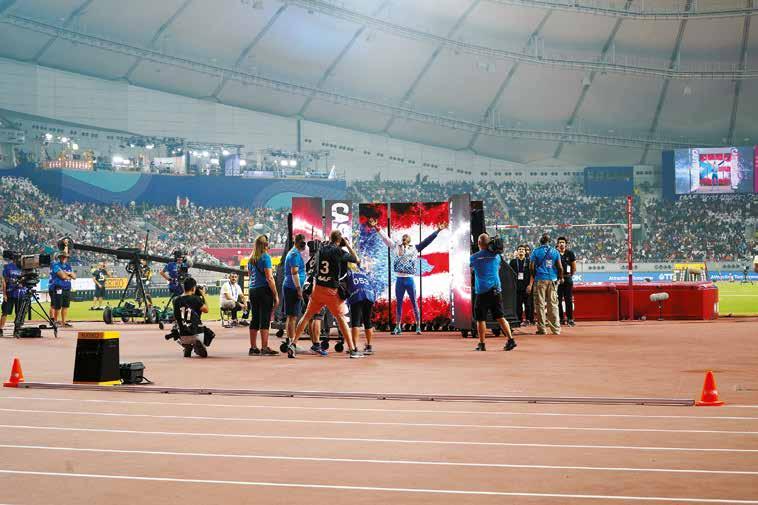
7 minute read
Trial Run
CT and NEP brought the recent World Athletics Championship to life, both inside and outside of Doha’s Khalifa Stadium. PRO AVL MEA heads to the blocks
When the IAAF World Athletics Championship arrived in Qatar for its 17th edition, the competition made headlines for all the wrong reasons. It was seen by many as somewhat of a trial run for the upcoming 2022 FIFA World Cup. Several people had doubts about the gulf state’s ability to host such a prestigious event with no prior experience. But these were purely logistical reasons. Typically, events like these attract negative coverage for either political or technical reasons, spectators can’t see or hear the action and miss that once-in-a-lifetime chance to see a record being broken. At Doha, it was the athletes that were upset, criticising, above all, the lack of spectators at the Khalifa International Stadium. With few live viewers, broadcasting coverage of the events out to the rest of the world took on an increased importance this year.

Athletes are projected onto the track during the opening ceremony
The 10-day competition is one of the largest sporting events in the world and saw nearly 2,000 athletes from 209 countries compete. It also commands an impressive opening ceremony to rival that of any other top-level sporting event. IAAF event presentation manager Florian Weber was responsible for the athletics presentation concept and challenged Creative Technology (CT) to deliver a projected track-athlete introduction that covered the entire running track, entertainment lighting, LED athlete entrances for both track and field positions, and an LED medal ceremony podium on top of the usual event presentation control and stadium relay screens.
International production company NEP was then tasked with creating the broadcast feeds that would be handed over to the event’s overall broadcast facility provider, ITN, via its client Blessed Productions. As a member of the NEP Group, CT and NEP were able to share resources and work in tandem on several aspects of the project.
‘Our local office fully supported the wider CT team with both human and technical resources,’ notes Irum Ashraf, CT’s Middle East general manager. ‘Having been part of several athletic meetings held in Doha over the last year, CT’s local office played a pivotal role in providing knowledge of the local market, which helped with our successful delivery. It’s a very exciting time for sport in Qatar right now and having a base here puts us in prime position to be involved in such great events in the future.’
In order to successfully deliver the track projection, it was essential that the stadium was dark. Naturally, switching the stadium lights off during a televised sports show is not something broadcasters are comfortable with, so Weber commissioned CT to deliver a VR model of the Khalifa Stadium featuring athletics apparatus, production overlay and the proposed LED screens and track projection to present to broadcasters to ensure they understood the concept. It quickly became adopted as a key pre-production tool for the IAAF as it allowed for pre-visualisation of the entire stadium. It also assisted the NEP team in pre-planning camera locations around the venue and even individual camera and lens specifications – reducing site visit requirements and overall broadcast costs.
To enhance the experience for those spectators inside the stadium, CT deployed over 500m 2 of curveable 4.8mm LED screens to display all the sports presentation content, including event information, live video feeds, athlete information and live results at key locations throughout the stadium. Eight mobile battery-powered LED monoliths that could be positioned anywhere around the athletics arena displayed live data for athletes’ names and country flags were also used for the first time at such an event.

Over 100 21,000- and 31,000-lumen laser projectors were called on
The highlight of CT’s involvement was undoubtedly the track projection, with over 100 21,000- and 31,000-lumen laser projectors deployed to project custom content across the entire running track. Over a year in planning, CT hired a local athletics track close to its headquarters in London to undergo a feasibility study, measuring the required light levels for good image visibility and monitoring the colour of the projected image on the track surface alongside other LED display devices. The projector placement and required light levels were then modelled in a VYV Photon media server to work out how to project a single continuous image, while taking into consideration environmental and structural constraints of the stadium as well as other stakeholder requirements.
CT provided cameras and switching to ensure a seamless delivery of the sports presentation content for the stadium LED screens, which included EVS playback, custom graphics, and real-time edit and playback for production highlights. In all, 24 broadcast and dedicated camera feeds were fed into the PPU and sent out via the switcher as four separate HD video outputs, each fed to the stadium control system over a Riedel MediorNet wide area network (WAN). Communication and audio feeds were also transported along with the video signals via the MediorNet WAN.
The German intercom specialist was also the brand of choice for the event presentation and broadcast production teams’ comms requirements. The event presentation setup was built around a Riedel Artist 128 matrix, featuring 16 comms panels and 12 ways of Riedel C3 beltpacks. Also managed through the Artist matrix were 20 Bolero wireless beltpacks for the floor management team and four CCP-1116 commentary units. As a backup, CT supplied 50 duplex portable radios. For the broadcast rights holders, 150 portable radios with 18 duplex talkback channels linked with the stadium via an audio-overfibre solution.

More than 500m 2 of curveable LED screens were deployed inside the stadium
Given the publicised issues at the event, the broadcast perhaps took on an even more important function than normal. ‘CT were awarded the inside contract themselves while we got the broadcast contact,’ explains Jimmy Parkin, NEP senior broadcast sound engineer. ‘But because we’re both under the same group, we ended up working on some aspects jointly where possible.’
To cover the action, NEP deployed a grand total of 97 video cameras and more than 150 mics from Audio-Technica, Sennheiser and Sony, and created 10 production galleries onsite outfitted with flyaway equipment. ‘The high number of galleries was due to the temperature in Doha, which meant the organiser had to stack all of the competition in the evening,’ notes Parkin. ‘Usually the field events would be spread out across the morning, afternoon and evening but this wasn’t possible in Doha. We had to cover a lot of stuff all happening at the same time.’
In terms of creating the broadcast audio feeds for the competition, the setup favoured by NEP bore a striking resemblance to that used by NEP at the Wimbledon Tennis Championships held each year in London. It included three Artemis, five Summa and two Brio audio consoles from British manufacturer Calrec Audio, all interconnected over its proprietary Hydra2 network.
‘The Hydra2 network is crucial because it gives us the benefit of input sharing with mic gain and phantom control,’ shares Parkin. ‘Nothing else yet allows you to do this on a Calrec desk. The gain at the top of the fader channel is the head-amp gain for the shared I/O.
We have to control mic amp gains and there’s a lot of moving and shuffling about of equipment. With Hydra, anyone can get across anything. The world feed desk, for example, needs to be able to see everyone’s output in order to know what to fade up and make live.’
Full-size Calrec Artemis consoles were deployed in the World Feed and Track galleries, with an Artemis Lite preferred for the IAAF Presentation gallery. The five Summas and the pair of Brios took care of the seven Field galleries. NEP deployed approximately 150 microphones to capture the track and field action. Models included Sony’s ECM77, Sennheiser’s MD40, MKH 416, MKH 418 and MKH 816, and Audio-Technica’s AT-897, AT-4029, AT Pro-42 and AT Pro-45.
It would be easy to assume that a big production company like NEP follows a tried-and-tested method working on large important events. ‘The beauty of flyaways is that you can trial new stuff,’ says Parkin. ‘If it doesn’t work properly, it doesn’t really matter, unlike a truck where everything has been fully integrated. The ability to change stuff on the fly as we’re fed different information about the event can be very useful.’
The attendance issues at the event garnered international attention, and video clips from inside the Khalifa Stadium were duly disseminated to news organisers around the world. Despite initial setbacks, local attendance did pick up in the competition’s remaining days and, from a technical standpoint, the games went off without a hitch. Nothing stands in the gulf state’s way as all eyes focus on the upcoming World Cup.










